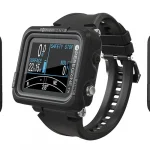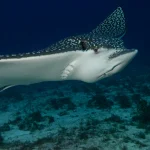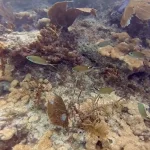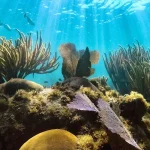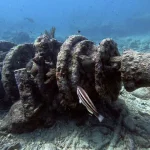Table of Contents
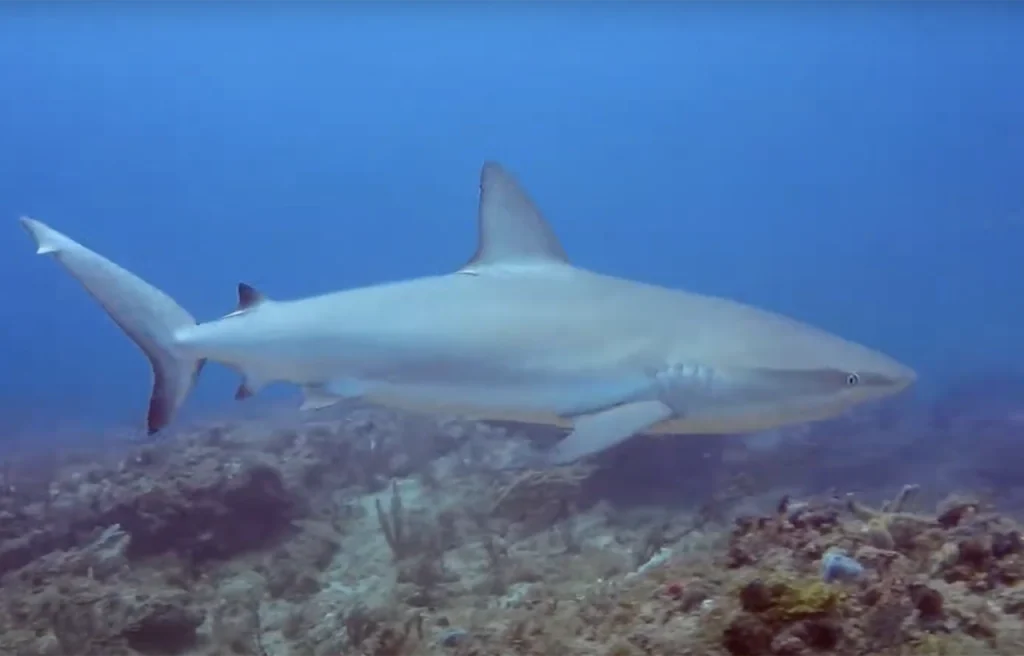
Spadefish Point not only offer diverse marine encounters but also showcase stunning underwater landscapes that make each dive unique. Divers are treated to an unforgettable experience filled with vibrant marine life and breathtaking scenery.
Article at a Glance
- Location: Spadefish Point is situated in Jupiter, Florida, known for its vibrant marine life and stunning underwater landscapes.
- Depth Range: The dive depths typically range from 65 to 90 feet (20 to 27 meters), making it suitable for intermediate to advanced divers.
- Visibility: Divers can expect visibility between 25 to 60 feet (7.5 to 18 meters), with optimal conditions generally occurring from January to April.
- Marine Life: The site is home to diverse species, including Atlantic spadefish, Goliath groupers, reef sharks, and various sea turtles, offering excellent opportunities for wildlife encounters.
- Best Diving Seasons: January to April is ideal for shark sightings, while August to September is prime time for observing Goliath groupers during their spawning season.
- Current Conditions: The site can experience varying currents, making it suitable for drift diving; divers should be comfortable managing buoyancy and navigation in these conditions.
- Photography Opportunities: Spadefish Point offers exceptional underwater photography prospects due to its vibrant colors and dynamic marine life, particularly around ledges and tunnels.
Spadefish Point Jupiter
- Depth: The dive starts at approximately 68 feet, with ledges dropping to about 80 feet.
- Marine Life: Divers can expect to see a variety of species including:
- Turtles: Loggerhead, Hawksbill, and Green turtles are commonly spotted.
- Fish: Large schools of tropical fish such as Bermuda chubs, Creole wrasses, and the namesake spadefish populate the area. Additionally, Goliath groupers and various species of sharks (including Black Tip and Caribbean Reef sharks) are often seen.
- Other Species: Nurse sharks and eels can be found hiding in the crevices of the ledge.
Features of Spadefish Point
- Topography: The site features dramatic ledges with overhangs that provide shelter for marine life. The ledges have sharp lines and varied depths, making it suitable for both novice and experienced divers.
- Visibility: Generally known for good visibility, divers often report clear conditions that enhance the experience.
- Photography Opportunities: The underwater landscape includes arches and vibrant coral formations, making it a favorite spot for underwater photography.
Diving Experience
Diving at Spadefish Point is described as dynamic and engaging. Many divers note that the area feels alive with activity, particularly around “the point,” where schools of fish gather in abundance. The dive is characterized by its ease of navigation, allowing divers to explore various depths and features without difficulty.
What Marine Life Can I Expect To See?
- Atlantic Spadefish: Large schools of these distinctive fish are prevalent, characterized by their silver bodies with black vertical bars. They often gather in groups, providing an impressive sight for divers.
- Goliath Groupers: These massive fish are commonly spotted around the reef, especially during spawning seasons when they may gather in larger numbers.
- Reef Sharks: Various species of sharks, including Caribbean reef sharks and nurse sharks, are frequently seen patrolling the area.
- Turtles: Multiple species, including Loggerhead, Hawksbill, and Green turtles, are often encountered. Loggerheads can frequently be found resting under ledges, while Hawksbills may be seen feeding.
- Other Fish Species:
- Bermuda Chubs
- Creole Wrasses
- Horse-Eyed Jacks
- Grunts
- Barracuda: Small groups of these predatory fish can also be observed.
- Moray Eels: Green morays and spotted morays are common residents, often found hiding in crevices and ledges.
- Southern Stingrays: These rays can be seen gliding along the sandy bottom of the dive site.
Additional Marine Life
- Invertebrates: A variety of sponges and corals contribute to the biodiversity of the reef ecosystem.
- Occasional Sightings: Divers may also encounter dolphins, sailfish, and marlins during their dives.
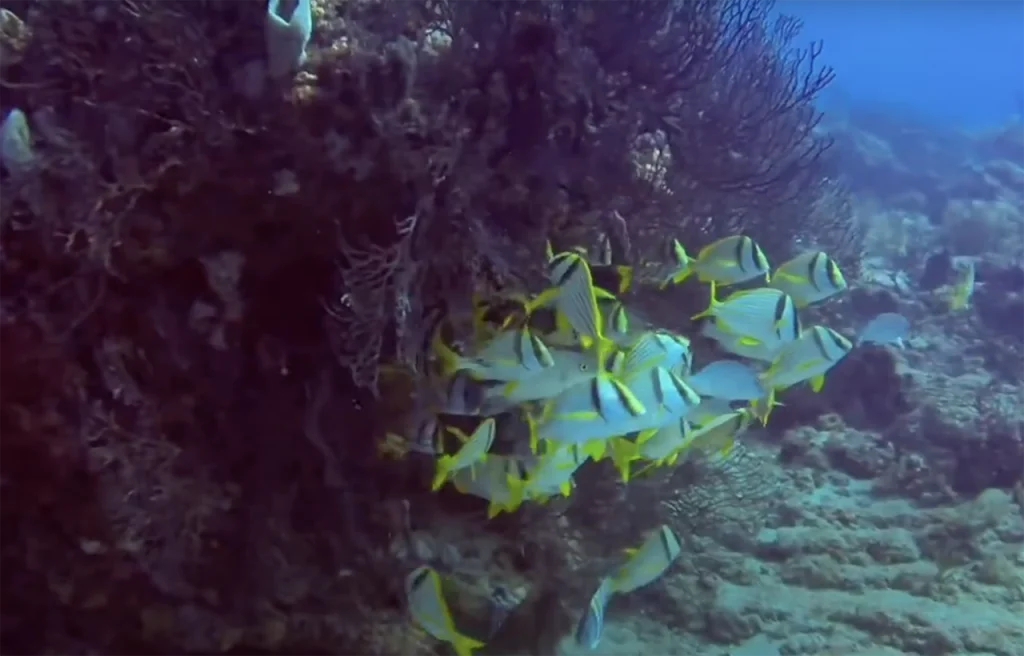
What Do Divers Say About This Site?
General Impressions
- Diverse Marine Life: Many divers emphasize the abundance of marine species at Spadefish Point, including large schools of Atlantic spadefish, Goliath groupers, and various species of turtles (Loggerhead and Hawksbill). The presence of reef sharks adds to the excitement of the dives.
- Stunning Underwater Topography: The underwater landscape is frequently described as breathtaking, with ledges, crevices, and a rich ecosystem that provides numerous exploration opportunities. Divers appreciate the “explosion of fish” at the point, where large schools can be seen at different depths.
Dive Conditions
- Visibility: Divers report good visibility conditions, often ranging from 25 to 60 feet, which enhances the overall experience. Clear days are particularly praised for allowing stunning views of the underwater scenery.
- Challenging Yet Rewarding: While some divers note that conditions can occasionally be challenging, particularly with currents, they find that the rewards—such as encountering large marine animals—make it worthwhile.
Crew and Safety
- Professional Dive Operators: Reviews consistently mention the professionalism and friendliness of dive shop crews. Divers feel safe and well-cared for by knowledgeable staff who prioritize safety and enjoyment.
- Customer Service: Many divers highlight excellent customer service from local dive shops like Jupiter Dive Center and Kyalami Jupiter. The crew’s attentiveness and support during dives contribute significantly to positive experiences.
Overall Recommendations
- Highly Recommended: Overall, divers recommend Spadefish Point as a must-visit location for both novice and experienced divers. The combination of diverse marine life, beautiful underwater scenery, and professional dive operations makes it a standout destination in Florida.
Key Information
| Key Information | Details |
|---|---|
| Location | Jupiter, Florida |
| Depth Range | 65 to 90 feet (20 to 27 meters) |
| Visibility | 25 to 60 feet (7.5 to 18 meters) |
| Best Diving Season | January to April (shark season) August to September (Goliath grouper spawning) |
| Marine Life | – Atlantic spadefish – Goliath groupers – Reef sharks – Loggerhead and Hawksbill turtles – Various tropical fish species |
| Current Conditions | Varies; can be strong, suitable for drift diving |
| Skill Level Recommended | Intermediate to Advanced divers preferred |
| Guided Dives Available | Yes, recommended for beginners |
| Notable Features | – Dramatic ledges – Tunnels – Abundant marine biodiversity |
| Photography Opportunities | Excellent; vibrant colors and diverse marine life |
Highlights of Diving This Site?
Marine Life Encounters
- Diverse Species: Divers frequently encounter large schools of Atlantic spadefish, along with Goliath groupers, reef sharks, and various species of turtles, including Loggerhead, Hawksbill, and Green turtles. The presence of these species creates a lively atmosphere underwater.
- Shark Sightings: Reef sharks are commonly seen shortly after descending, often swimming close to divers. There are also reports of occasional sightings of Blacktip and Caribbean reef sharks, adding an element of excitement to the dive.
- Other Fish: The site is home to numerous other fish species such as barracuda, bar jacks, amberjacks, and horse-eye jacks. Divers often note the abundance of fish life that surrounds them, creating a dynamic underwater environment.
Underwater Landscape
- Topography: Spadefish Point features dramatic ledges that drop from about 68 feet to deeper areas. The underwater landscape includes numerous crevices and tunnels that provide excellent exploration opportunities. This varied topography is known for its sharp lines and high ledges.
- Unique Features: The site is often described as the “Baskin Robbins of the Sea” due to its incredible marine diversity. The crystal-clear “Jupiter Blue” water enhances visibility and makes for stunning underwater photography.
Dive Conditions
- Visibility: Generally, visibility ranges from 25 to 60 feet, depending on seasonal conditions, which allows divers to enjoy the vibrant colors and life forms present at the site.
- Best Time to Dive: The ideal times for diving are from January to April for shark activity and from August to September during Goliath grouper spawning seasons. These periods offer the best chances for encountering large marine life.
Exploration Opportunities
- Tunnels and Crevices: Divers are encouraged to explore the various tunnels and high ledges that characterize Spadefish Point. These areas are not only visually stunning but also serve as habitats for many marine species.
- Dynamic Interactions: Each dive can present unpredictable encounters with marine life, making every visit unique. Divers often report thrilling experiences as they navigate through schools of fish or come across larger species like Goliath groupers and sharks.
My Favorite Dive Computers
I have compared the 3 top diving computers for each category to help making the right choice easier:
Iconic Spots At This Site
Scarface
- Description: Named after a legendary scarred green moray eel, Scarface features stunning underwater topography with high ledges and numerous crevices.
- Marine Life: Expect to see a variety of species, including Loggerhead turtles, Hawksbill turtles, Goliath groupers, and schools of Atlantic spadefish. This area is known for its vibrant ecosystem and is often described as a “Baskin Robbins of the Sea” due to the diversity of marine life encountered .
Tunnels
- Description: Renowned for its underwater tunnels, this spot is a favorite for encountering larger aquatic life.
- Highlights: Divers can navigate through the tunnels while spotting Goliath groupers, reef sharks, and southern stingrays. The first tunnel is particularly noted for having several Goliath groupers that may be observed as divers approach .
Area 51
- Description: This site is known for its high ledges and rich marine life, where divers often encounter curious reef sharks shortly after descending.
- Marine Life: In addition to reef sharks, divers can expect to see Loggerhead turtles and various tropical fish species. The underwater landscape here is characterized by dramatic ledges and crevices that provide excellent exploration opportunities .
The Point
- Description: Often referred to simply as “the point,” this area features a dramatic curl in the ledge where marine life congregates.
- Marine Life: Divers frequently experience an explosion of fish activity here, with large schools of Bermuda chubs, Creole wrasses, horse-eyed jacks, and of course, spadefish. The presence of resident Goliath groupers and reef sharks adds to the excitement .
Environmental Conservation Efforts at Spadefish Point Jupiter
Sawfish Bay Marine Restoration Project
- Objective: This multi-year initiative aims to enhance marine habitats through several strategies:
- Installation of a living shoreline to reduce erosion and improve habitat.
- Restoration of marine habitats by promoting the growth of seagrass and oysters.
- Installation of artificial reef modules to provide additional structures for marine life.
- Efforts to improve water quality and contribute to the recovery of threatened and endangered species .
Jupiter Inlet District Conservation Efforts
- Focus: The Jupiter Inlet District works to maintain the inlet and navigable channels while preserving important waterways and natural resources. This involves:
- Protecting wildlife in the Jupiter Inlet and surrounding aquatic preserves (1).
- Implementing measures to safeguard habitats from degradation .
Marine Protected Areas (MPAs)
- Purpose: The establishment of MPAs in Florida aims to safeguard critical habitats and species from overfishing and habitat degradation. These areas help maintain biodiversity by restricting harmful activities such as fishing and anchoring on coral reefs (2).
General Conservation Practices
- Divers are encouraged to practice responsible diving techniques, which include:
- Avoiding contact with marine life and underwater habitats.
- Being mindful of environmental impacts while diving, thus promoting a culture of conservation among the diving community (3).
Removal of Derelict Vessels
- Efforts are being made to remove derelict vessels that pose threats to marine life and habitats. Recent initiatives have focused on removing abandoned boats from local waterways, which can leak oil and debris into the environment .
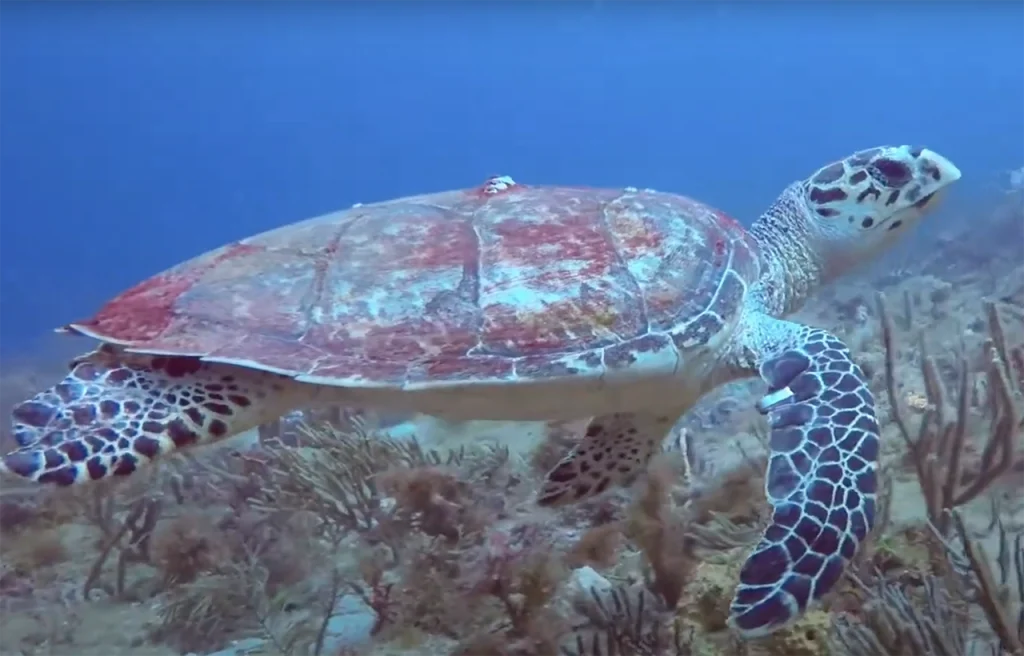
Maximizing Your Diving Experience at Spadefish Point Jupiter
Preparation and Equipment
- Know Your Gear: Familiarize yourself with your diving equipment, especially if using a Surface Marker Buoy (SMB) for drift diving. Many dive shops provide SMBs if you don’t have one .
- Weight Adjustment: If you’re using 100cf steel tanks instead of the standard aluminum 80s, adjust your weight accordingly, as steel tanks are heavier .
Dive Techniques
- Drift Diving: Be prepared for swift currents typical of this area due to the proximity of the Gulf Stream. Proficiency in drift diving techniques is essential for a safe and enjoyable experience. Ensure you are comfortable with live boat (unmoored) diving practices .
- Explore Different Depths: Spadefish Point features varied depths ranging from 60 to 90 feet. Divers can choose to explore the top edge of the ledge or venture deeper to encounter different marine life, such as turtles and Goliath groupers .
Marine Life Encounters
- Timing Your Dive: The best times for marine life encounters vary by season. For instance, January to February is lemon shark season, while Goliath groupers are more active during their spawning season from August to September .
- Look for Specific Species: Keep an eye out for:
- Sharks: Expect to see Caribbean reef sharks and possibly hammerheads.
- Turtles: Look for Loggerhead, Hawksbill, and Green turtles resting or feeding among the ledges .
- Schools of Fish: Large schools of spadefish, Bermuda chubs, and other reef fish create stunning underwater visuals.
Dive Site Highlights
- Iconic Features: Don’t miss notable spots like “The Point,” where you can witness an “explosion of fish” activity. This area is known for its vibrant marine life and dramatic underwater landscape .
- Photographic Opportunities: The underwater topography provides excellent opportunities for photography, especially around arches and ledges where schools of fish gather. The cul-de-sacs along the ledge offer unique perspectives and compositions .
Safety Considerations
- Buddy System: Always dive with a buddy and maintain close communication throughout your dive. This enhances safety and allows for shared experiences.
- Respect Marine Life: Practice responsible diving by avoiding contact with marine animals and their habitats. This ensures that the ecosystem remains healthy for future divers .
Capturing Memories at Spadefish Point in Jupiter: Photography Tips
Equipment Recommendations
- Camera Setup: Use a wide-angle lens, such as a fisheye or rectilinear lens, to capture expansive underwater scenes and large marine life. A fisheye lens is particularly effective for close encounters with curious species like sharks and turtles.
- Strobes: Position your strobes high and wide to illuminate your subjects effectively while minimizing backscatter. This setup helps maintain the vibrant colors of marine life and reduces the risk of blowing out sandy bottoms in your shots (5).
Shooting Techniques
- Get Close: Proximity is crucial in underwater photography. The closer you are to your subject, the more detail you’ll capture. Aim to fill the frame with your subject to create impactful images.
- Stay Calm and Patient: Many marine creatures, including sharks, are naturally curious. Remain still and calm to allow them to approach you, which increases your chances of capturing great shots without startling them.
- Use Natural Light: When diving in shallower areas, take advantage of natural light to enhance color saturation in your images. This can be particularly effective during sunny days (4).
Composition Tips
- Framing: Pay attention to how you frame your shots. Use the underwater environment creatively to add context and depth. For larger subjects like sharks or turtles, ensure they are well-positioned within the frame.
- Background: Maintain a bright and blue background by adjusting your strobes accordingly. This contrast can help make your subjects pop in the final images.
- Shoot Upward: When photographing reefscapes, consider shooting from below and angling your camera upward. This technique captures lighter water colors above, creating a pleasing background with vibrant blues or greens.
Planning Your Shots
- Pre-Dive Preparation: Think about the types of shots you want to capture before diving. Consider including divers in some shots for scale but ensure they do not touch or disturb the reef.
- Explore Unique Features: Take time to explore iconic spots at Spadefish Point, such as tunnels and ledges, where you can find diverse marine life. Each area offers unique photographic opportunities.
Frequently Asked Questions
When is the best time to dive Spadefish Point?
The best time to dive at Spadefish Point in Jupiter, Florida, varies depending on the marine life you wish to encounter and the overall diving conditions.
Best Times to Dive
January to April: This period is considered prime for shark sightings. Divers can expect to see lemon sharks and migrating blacktip reef sharks, making it an exciting time for shark enthusiasts. Visibility during these months is generally good, often ranging from 25 to 60 feet.
March to September: This timeframe is excellent for encountering sea turtles, as it coincides with their nesting season. Loggerhead and Hawksbill turtles are commonly spotted during these months.
August to September: This is the peak season for Goliath groupers, which aggregate to spawn during late summer. Divers have a higher chance of seeing these large fish during this time.
What is the visibility like while diving Spadefish Point?
At Spadefish Point in Jupiter, Florida, divers can typically expect visibility ranging from 25 to 60 feet (approximately 7.5 to 18 meters). The best visibility conditions are often experienced from January to April, coinciding with the peak shark season and generally clearer waters during this time.
Visibility Overview
Average Visibility: Generally ranges from 25 to 60 feet.
Seasonal Variations: Visibility can fluctuate based on weather conditions, currents, and seasonal changes. Reports indicate that conditions can be less favorable during certain months, especially after storms or heavy rainfall, which may reduce visibility to around 10 to 20 feet in some cases.
Factors Influencing Visibility
Water Conditions: The presence of sandy bottoms and potential currents can occasionally stir up sediment, impacting clarity.
Time of Year: Optimal diving months (January to April) tend to offer the clearest waters, while summer months may see more variability in visibility.
How deep are the dives at Spadefish Point?
At Spadefish Point in Jupiter, Florida, divers can expect varying depths during their dives. The typical depth profile is as follows:
Top of the Ledge: Approximately 65 to 75 feet (20 to 23 meters).
Bottom of the Reef: Around 80 to 90 feet (24 to 27 meters), with some areas reaching up to 90 feet for those who explore deeper sections.
Is Spadefish Point suitable for beginners?
Spadefish Point is generally considered suitable for divers with some level of experience, but it may not be the best choice for complete beginners.
Depth and Experience Level
Depth: The dives at Spadefish Point typically range from approximately 65 to 80 feet(20 to 24 meters). While this depth is manageable for certified divers, it may be challenging for novice divers who are not yet comfortable with deeper dives or managing buoyancy effectively.
Training Requirements: Beginner divers are usually recommended to stick to shallower depths, typically no more than 40 feet (12 meters) for their initial dives. This depth allows them to gain confidence and experience without the added pressure and complexities associated with deeper diving.
Environmental Conditions
Currents: Spadefish Point can experience varying currents, which may pose additional challenges for inexperienced divers. Managing buoyancy and navigating in currents requires a certain level of skill that beginners may not have yet developed.
Recommendations
Guided Dives: If a beginner is interested in diving at Spadefish Point, it is advisable to do so as part of a guided dive with an experienced instructor or dive master. This ensures safety and provides the opportunity to learn in a controlled environment.
Is Spadefish Point suitable for advanced divers?
Spadefish Point is indeed suitable for advanced divers, offering a range of features and experiences that cater to their skills.
Depth and Topography
Depth Range: The dives at Spadefish Point typically range from 65 to 80 feet(approximately 20 to 24 meters), with some areas reaching up to 90 feet (27 meters). This depth allows advanced divers to explore intricate underwater topography, including ledges and crevices filled with vibrant marine life.
Marine Life Encounters
Diverse Species: Advanced divers can expect encounters with larger marine species such as Goliath groupers, reef sharks (including Caribbean reef sharks), and various species of turtles. The presence of these species provides ample opportunities for photography and observation.
Drift Diving Experience
Current Conditions: Spadefish Point is known for its drift diving opportunities, which can be exhilarating for experienced divers. The currents can vary in strength, allowing advanced divers to navigate the reef while enjoying the thrill of drifting along the underwater landscape.
Recommended Experience Level
Certification Requirements: Many dive operators recommend that divers have at least an Advanced Open Water certification due to the depth and potential currents. This ensures that divers are comfortable with deeper dive profiles and can manage buoyancy effectively .
Jupiter Dive Sites
- Area 51
- Area 29
- Tunnels
- Loggerhead Reef
- Bluffs Reef
- Bonnies
- Captain Kurls
- Spadefish Point
- Coral Cove Park
- Captain Mike’s
- Julies
- Emerald Charters Shark Dive
- Jupiter Wreck Trek
- Donut
- Scarface Reef Andrew “Red” Harris No Shoes Reef
- Jupiter Inlet
- Step Reef
- Sawfish Bay
- Marine Restoration Reef
- North County Reef
- Lighthouse
- Finz Den
- High Ledge
- Leigh’s Ledge
- Monkey’s Ledge
- Gary’s

